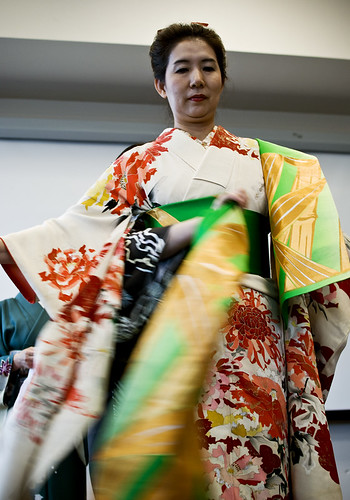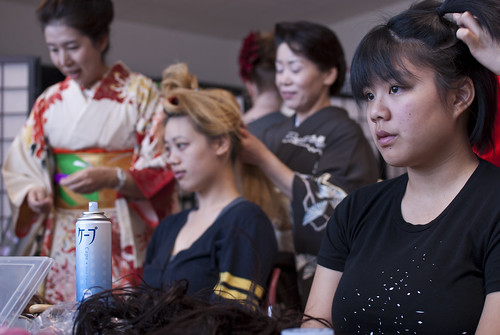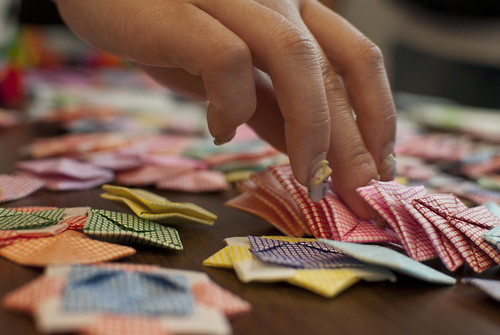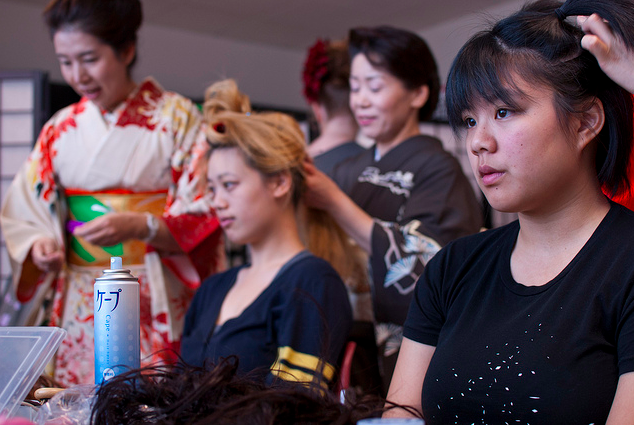
A Japanese student in a bright red kimono teetered into the Humanities Symposium on black, glossy 24-centimeter tall platform sandals Tuesday, as one of the sights to behold at the Kimono Show at SF State.
Ten SF State student volunteers modeled kimonos alongside 12 students from the Yuki Kimono School in Tokyo to the tune of Christina Aguilara’s “Dirrty” and various traditional Japanese songs, highlighting the multicultural nature of the event.
Ayako Ozaki, an assistant teacher in the Yuki Kimono School, explained the goals organizers hoped to accomplish through the show.
“We want everyone to really experience, first hand, the beauty of Japanese kimonos, and want to introduce everyone to Japanese culture,” Ozaki said.
Midori McKeon, the coordinator of SF State’s Japanese program, said the purpose of the event was to further cultural understanding for students from both sides of the Pacific Ocean.
“This is not an ordinary kimono fashion show, but an educational cultural exchange event between the students of Yubi Kimono school and our own San Francisco State students,” McKeon said. “Some of our students are participating in the event as models, experiencing firsthand how it feels like to wear a kimono and how it affects them physically and psychologically.”
Several different kinds of kimonos were featured at the event, ranging from the casual cotton yukatas, which were used as “working attire in the Edo era,” to furisode kimonos, which use traditional patterns but are still used in Japan today as formal wear, according to McKeon.
Enya Barcelon, a SF State volunteer model, was taken aback by how complex it was to wear one of the formal kimonos.
“It took me about 30 to 40 minutes to get ready. I had more than one person help me. I had about two or three,” said Barcelon, a junior majoring in Japanese. “[Kimonos] are very cylindrical, very flat. There’s a lot of ties, there’s a lot of padding and strapping down. I’m wearing about four layers. When we start moving it’s going to be a lot hotter.”
Napat Kanjanametaku, a senior studying Japanese who volunteered for the show, was particularly excited for a chance to wear a kimono.
“The professor asked us in class to do it and I’d really like to try it on for once in my life,” said Kanjanametaku, an international student from Thailand with hopes to become a translator.
Arisa Hiroi, a graduate student studying Japanese and a volunteer model, explained that one of the event’s goals was to showcase the movement potential that kimonos have.
“Just to show everyone what the Japanese yukata is, and to show how people can move freely in them as opposed to how it looks really constricted. It’s actually free flowing,” said Hirio, who wore one of the casual kimonos.
This goal was accomplished in the opening act of the show, where five male volunteers dressed in yukatas performed their own interpretations of famous dance moves such as “the sprinkler” and “the running man.”
The show, which had more than 100 attendees, was preceded by a lecture on the history of kimonos and followed by a cultural workshop on Japanese calligraphy and origami.






